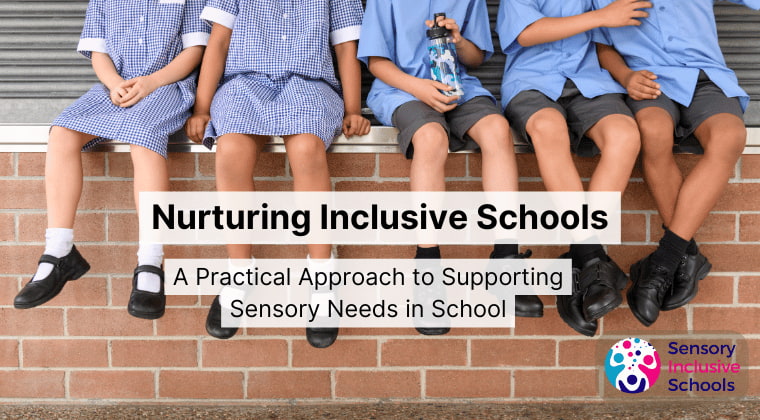Keep building your sensory inclusion skills
Find online sensory training and webinars for teachers and school staff, packed with practical strategies to make your classrooms more inclusive for every student.
By Sensory Inclusive Schools, 2 February 2024

Acknowledging and accommodating the diverse sensory needs of students benefits the individual student and, by extension, their family, fellow students and school staff and enhances the organisation's reputation.
Students with sensory integration and processing differences often face barriers to accessing the early years and school curriculums. They risk reduced educational attainment, school refusal, poor emotional well-being and school placement breakdown.
By understanding a student's unique sensory needs, staff can make the necessary environmental adaptations, adapt tasks and support with appropriate sensory strategies to remove these barriers. This will improve educational outcomes and the overall well-being of students. Like you, our priority is to help children stay in class, learn alongside their peers and have a happy educational experience.
Learn more about what sensory integration and sensory processing differences look like in school with our webinar "Sensory Integration - What Teachers Need to Know". Of course, all school staff, including teaching assistants, SENCos, school leaders and learning support assistants, would benefit from this free webinar, too.
Sensory processing refers to how our body receives and interprets incoming stimuli through our senses. It's our brain's way of understanding the world around us and what's happening inside us - and whether to react to or ignore that information. (You may also see it referred to as sensory integration.)
We all experience differences in the way our brain and body deal with sensory input, but some people's differences make everyday activities hard. Their sensory processing differences may mean they react differently to sensory input. It can also mean that they have differences in how they plan and coordinate their movements.
For some quick definitions of sensory integration and processing needs, have a look at our FAQs here.
Let's clarify what we mean by sensory inclusion in schools. Sensory inclusivity involves actively adjusting environments and educational practices to cater to the diverse sensory needs of students. This includes recognising and addressing unique ways individuals process sensory information, such as sensitivities to light, sound, touch, and other stimuli, as well as their ability to plan, coordinate, and carry out movement.
In a sensory-inclusive educational approach, staff make adjustments to classrooms, teaching materials, schedules and activities. The goal is to ensure that every student can fully engage and participate comfortably. This commitment creates an inclusive learning environment where students with varying sensory preferences, needs or sensitivities can thrive. Whether it's creating sensory-friendly learning spaces, using flexible teaching methods, or providing resources for diverse sensory experiences, a sensory-inclusive educational setting prioritises the well-being and learning success of every student.
Let's take a closer look at what creating an inclusive school experience means in practice.
Acknowledging Students' Sensory Needs:
In your classrooms, students come with various sensory preferences and sensitivities. Understanding and respecting these differences is essential for creating an environment where everyone feels comfortable and included.
Creating Comfortable Learning Environments:
By making adjustments to address diverse sensory needs, you can transform your classrooms into spaces that support everyone's learning. This can lead to improved academic performance, increased confidence, and a more positive school experience.
Building Inclusive Social Connections:
Adapting your classrooms for sensory inclusivity fosters understanding and compassion among students. This helps build a sense of community where everyone feels valued and included.
Supporting Students with Sensory Processing Differences:
By acknowledging and addressing these differences, you can implement strategies and accommodations that empower students to succeed academically and socially.
Empowering Special Education Needs Coordinators (SENCos):
SENCos play a vital role in championing inclusivity. Providing them with resources and support enhances their ability to advocate for the sensory needs of our students.
Navigating Legal and Ethical Considerations:
Upholding principles of equal access and non-discrimination is both a legal obligation and a moral imperative. Acknowledging and accommodating diverse sensory profiles aligns your practices with the ethical core of inclusive education.
If you would like support in implementing practical strategies to create a more inclusive and supportive learning environment for students with sensory processing differences, we are here for you.
Deployable at both the universal and targeted levels of support, Sensory Inclusive Schools is designed to work for and with schools where resources and access to sensory integration experts are limited.
Sensory Inclusive Schools combines high-quality training and ongoing support from qualified sensory integration-trained therapists to help educational settings create environments and curricula that support all students' unique sensory profiles.
You will have access to live online peer support drop-in sessions where you can ask for advice from a sensory integration practitioner as well as other educators. For rapid answers and support, post in the community forum, and we guarantee a response from a sensory expert within three working days.
Find out more about how Sensory Inclusive Schools can support you to support your students.